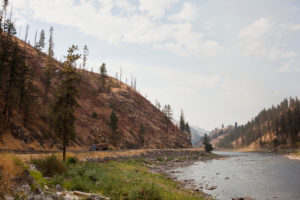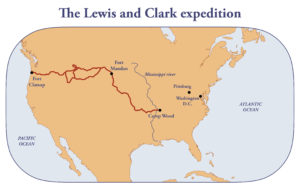
The Mullins family had two relatives on the Lewis and Clark expedition of 1804-1806: Sergeant Charles Floyd and Sergeant Nathaniel Pryor. Both men were 2nd cousins of our ancestor Martha Venable through her great grandparents Hugh Lewis (1645-1689) and Margaret Dallathy (1645-1720).
Sergeant Charles Floyd’s Experience On The Expedition
Just 20 years old, Charles was one of the first men to enlist for the trip in 1803 . . . one of “nine young men from Kentucky.” He had the unfortunate distinction of being the only member who died during the journey—dying in Iowa on August 20, 1804; probably from a ruptured appendix. Up until his death, he kept a daily journal that was published as part of the expedition record.
A monument was erected in Charles’ honor on Memorial Day, 1901, in Sioux City, Iowa. The monument is a 100-foot-high sandstone masonry obelisk, second in size only to that of the Washington Monument. Dr. Elliott Coues, editor of the 1893 annotated reprint of the 1814 Biddle Allen edition of the expedition journals, was the speaker of honor at the dedication of the monument. Coues spoke eloquently of the expedition:
“I must confess that I am what my friends call me—’a Lewis and Clark enthusiast.’ But I do not think that anyone can read that ‘national epic of exploration’ without sharing my enthusiasm. It is one of the grandest episodes in the history of our country. Every American can be proud of it. Every person in Missouri, Iowa, Kansas, Nebraska, South and North Dakota, Montana, Idaho, Oregon and Washington—for the expedition passed through all these states—has an interest in the immortal achievements of these dauntless pioneers. For every Iowan this interest focuses about the saddest incident of the whole journey—the death of Charles Floyd.”

Sergeant Nathaniel Pryor’s Experience On The Expedition
Nathaniel did well after the expedition. He was promoted to officer rank and served in the military for several more years. He fought in the Battle of New Orleans in 1813, after which he retired from the military to become a trader with indigenous tribes in Oklahoma. He lived until 1831.
Several places bear his name, including:
- Pryor, Montana
- Pryor Mountains, Montana
- Pryor, Oklahoma
- Pryor Creek, Oklahoma
Powhatan Princess Nicketti
Charles and Nathaniel, and Martha shared an indigenous American great great-grandmother—the Powhatan Princess Nicketti.
Many of Nicketti’s descendants inherited the physical features of Native Americans, including a deeper skin tone. It’s possible that Charles and Nathaniel were aware of their Native American heritage, and it might have been considered an advantage on the expedition across Indian country to the Pacific.
© 2013 W. Mullins
